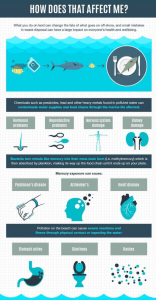Welcome back Ocean Olympians!
Did you know that 78 million tons of plastic packaging is produced annually and about 32 percent of it is released into the environment after production? This means that about 24,960,000 tons of plastic are being released into nature annually. To put that into perspective, that means about 55,027,380,641 pounds of plastic‒which is equivalent to about 137,568 full grown male hippos‒ can be found polluting our planet.

Plastic makes up a large amount of ocean debris. The image above shows some common plastics that enter the ocean and the impact they have on marine life.
Pollutants poisoning the ocean vary vastly but today we would like to bring a focus on plastics and toxic chemicals impacting our oceans.
According to planetaid.org, the world’s oceans provide over 97 percent of the world’s water supply, along with over 70 percent of the oxygen we inhale. Man-made pollution is challenging those statistics daily, as human actions are wreaking havoc on organisms beneath the ocean surface. Not only are human actions negatively impacting ocean organisms, but they are concurrently worsening human lives as well.
About 20 percent of plastic trash entering the ocean comes from offshore ships and platforms while the rest is blown into the sea, pulled in from beaches by tides, or deliberately dumped into the ocean, according to the Science Education Resource Center at Carleton College. Because these plastics are non-biodegradable, fish and other organisms consume them. Not only does the consumption of plastic contaminate sea animals, but just swimming in ocean water‒which is being contaminated by chemicals released from plastics in the ocean‒ is poisoning sea animals too. The food chain is becoming increasingly contaminated due to the impact of plastic found in the ocean.
Aside from plastic, chemicals like oil, mercury, lead, pesticides, and other heavy metals can all be found within ocean waters; These substances are also contaminating water supplies and corrupting our food chain through the poisoning of marine life. Exposure to such lethal chemicals for an extended period of time will contribute to an increase in poor health conditions‒like hormonal issues, reproductive problems, nervous system, and kidney damage‒within society.
Because every little tiny piece of contamination that enters the ocean adds up to create such a large amount of pollution, it’s important that we start thinking more carefully about even our smallest actions in our everyday life. Some ways to prevent further ocean pollution is to:
- Use reusable containers over Ziploc bags
- Bring reusable bags to stores so plastic bags aren’t used
- Drink from glass or reusable bottles rather than drinking from single-use plastic water bottles
- Join a cleanup crew for your area (Look for a Facebook group in your area or reach out to us and we can help you find one)
- Substitute plastic straws for other alternatives
- Reuse and recycle
- Save glass bottles from items like kombucha or jelly so you can store things in them rather than using Ziploc bags
- Lobby to your local government
- Spread the word about the importance of pollution prevention through word-of-mouth or by retweeting our twitter posts/sharing our informational blog posts!
Written by Emily Ram, revised and edited by Kailyn Hayes
